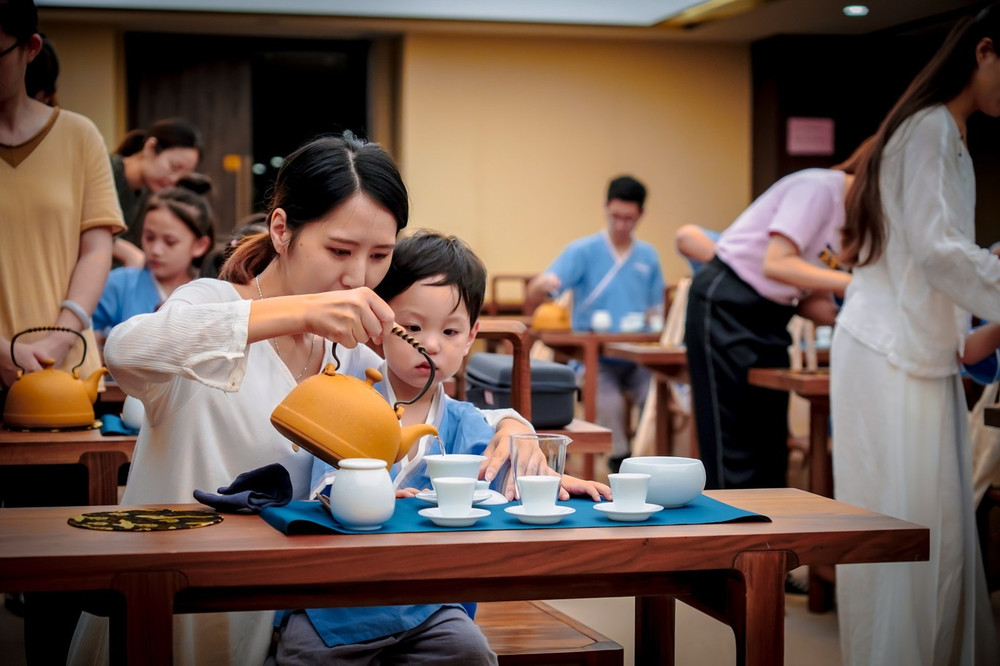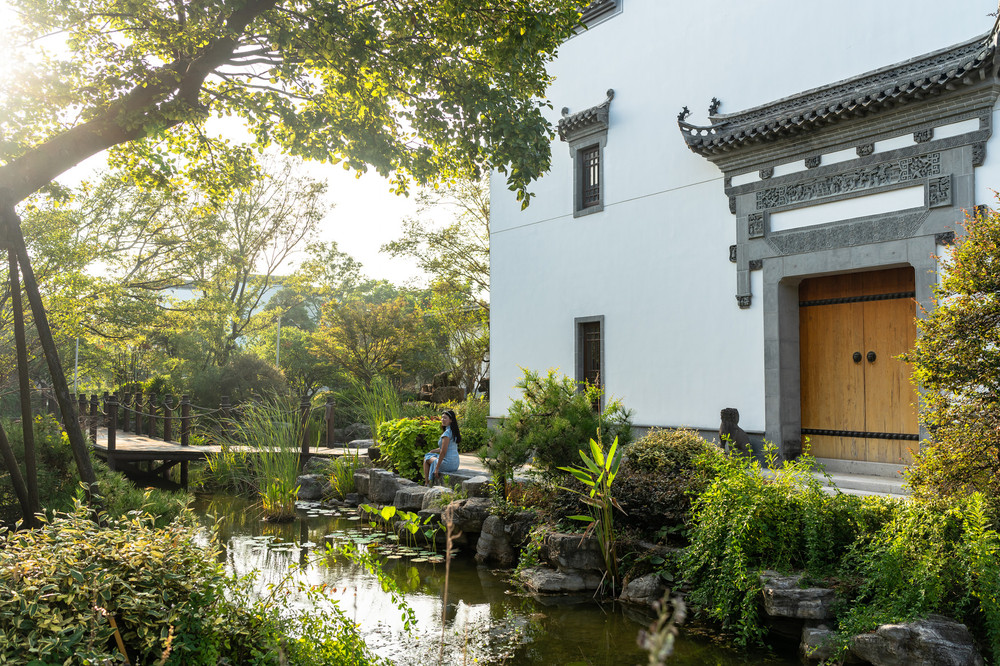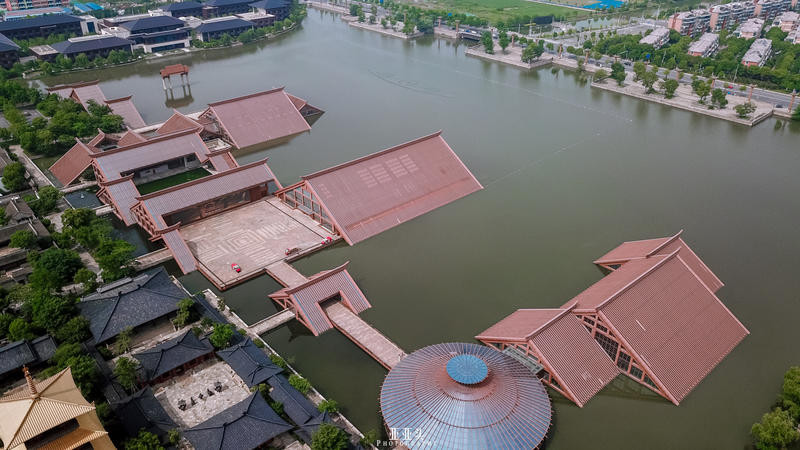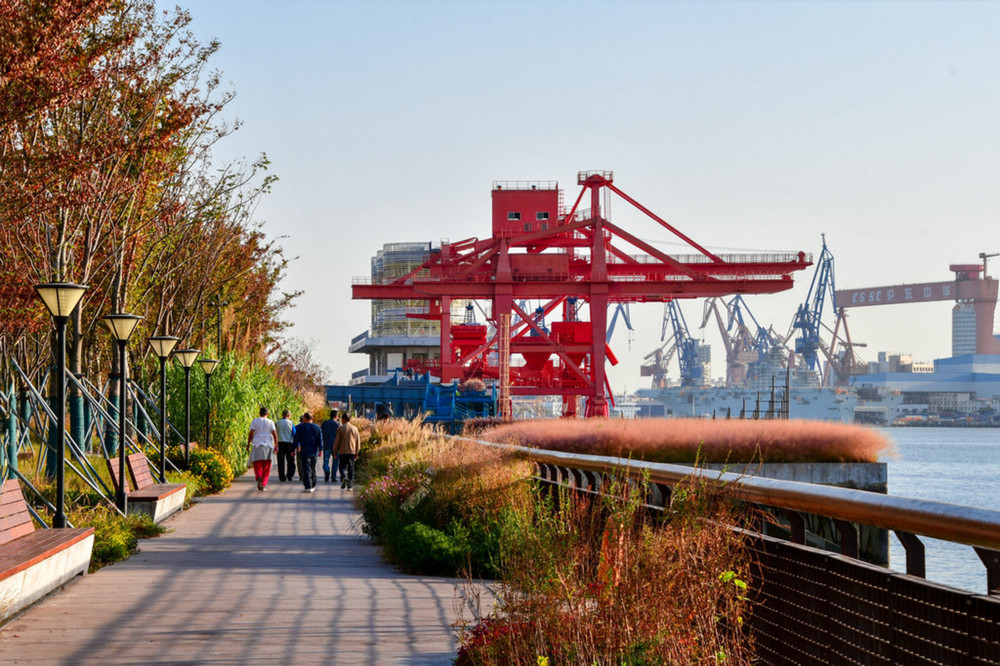Duration: 1 day
Time: March
Cost per person: 75 yuan
With whom: Spouses
Activities: Cultural, Freestyle Travel
The author visited these places: Qingpu
Published on 2021-04-12 13:55

Liantang Ancient Town, located in Qingpu District, has a history of over a thousand years as a town. It is an ancient town hidden in the suburbs of Shanghai and is the hometown of the old generation of proletarian revolutionaries, Comrade Chen Yun. Situated in the southwest of Qingpu District, Shanghai, it is adjacent to Songjiang District in the east and borders Jiaxing and Jiashan in Zhejiang to the southwest.
Liantang is also a famous ancient water town in Jiangnan with a history of over 1000 years, rich in cultural resources, abundant cultural relics, and has a profound cultural heritage. It is said that the Eastern Wu state during the Three Kingdoms period once built ponds here for training naval forces, hence the name; it is also said that the ancient town was named after Zhang Zaijun, the governor of Gaozhou during the Five Dynasties period, and his wife, Lady Lian, who once lived here.
In Liantang Ancient Town, you can still see the quiet demeanor of the ancient town and its lifestyle without crowds of tourists or shops everywhere. There is only a river running through the ancient town, connecting more than ten ancient bridges, creating beautiful scenery. More than ten bridges from the Yuan, Ming, and Qing dynasties span the market river, shaded by weeping willows. Each bridge has its own style. As people walk on them, water flows beneath, and the reflections of bridges, trees, houses, and people ripple in the gentle waves. ‘Tall houses, narrow alleys, facing buildings, small bridges, and flowing water form the unique landscape of Liantang.’
Liantang Old Street is the core of the ancient town. The old street is not long, just three miles long. A market river, commonly known as ‘Three Miles Pond,’ runs through the ancient town from east to west. Across the river, there are two stone-paved roads. One is called Shangtang Street (Dongfeng Street and Qianjin Street) and Liantang Xia Tang Street, located on the south bank of the market river, from Youjia Jing River to Fengjia Zhai, with a total length of about 720 meters, which is one of the Liantang old streets. Going west through the Old Zhufeng Highway, there is a ‘Xia Tang Street Noodle House’ on Xia Tang Street. Outside the noodle house, there are outdoor tables and chairs, and you can order dishes. Tourists like to sit outside and dine.
Wanshan Bridge: This bridge is a single-hole bridge, and it also has another name, Hun Tang Bang Bridge. It is a bridge built during the Qing Dynasty. Originally, it was a ring-hole bridge, then changed to a cement step arch bridge, and later changed back to become the stone arch bridge of today.
Liantang Abacus Cultural Museum, affiliated with the Chen Yun Memorial Hall, was specially established and constructed to allow visitors to understand the story of the great man Chen Yun while visiting. Mr. Chen Yun, known as the ‘Red Butler’ of the Republic, was indeed a master of abacus calculation. During the period when the old man was in charge of the national economic construction, he had a very profound strategy, and part of the roots of this strategy should come from the concept of abacus calculation. ‘Red Butler’ of the Republic – Chen Yun Comrade Chen Yun’s ‘Abacus Sutra’ ‘Abacus Cultural Museum’ displays super large abacuses and various abacuses and the concept of abacus calculation.
Auntie Pang’s Kitchen is the only shop in Liantang Ancient Town that makes stuffed meat, also selling handmade, freshly wrapped meat zongzi and date zongzi. In the kitchen, the old stove simmers the water town specialty stuffed meat and zongzi, filling the air with fragrance.
The Water Bamboo Leaf Weaving Pavilion is a very worthwhile attraction to visit. The weaving of water bamboo leaves is a folk hand-weaving skill that combines the historical straw and willow weaving skills with the local water bamboo plant industry. It witnesses the inheritance, development, and innovation of Shanghai’s folk skills. It is the crystallization of Shanghai’s folk wisdom and a true reflection of the development and progress of the times. Liantang has long been known as the ‘First Town of Water Bamboo in East China.’ Water bamboo is not only a delicious food on the dining table, but water bamboo leaves can also be woven into exquisite handicrafts.Liantang is a renowned ancient water town in Jiangnan with a history of more than a millennium. It has abundant cultural resources, numerous cultural relics, and a profound cultural foundation. There are legends that during the Three Kingdoms period, Eastern Wu built ponds here to train their navy, hence the name; another legend suggests that it was named after the wife of Zhang Zaijun, a governor of Gaozhou during the Five Dynasties, who resided here.
In Liantang Ancient Town, you can still catch glimpses of the tranquility of ancient times and the life within the town. There are no crowds of tourists or shops everywhere. Instead, there is a river that runs through the town, connecting more than ten ancient bridges, creating a beautiful scenery. More than ten ancient bridges from the Yuan, Ming, and Qing dynasties span the market river, shaded by weeping willows. Each bridge has its unique style. As people walk on them, water flows beneath, and the reflections of bridges, trees, houses, and people ripple in the gentle waves. The phrase ‘tall houses, narrow alleys, facing buildings, small bridges, and flowing water’ forms the unique landscape of Liantang.
The old street of Liantang is the core of the ancient town. It is not very long, just three miles. A market river, commonly known as ‘three-mile pond,’ runs through the town from east to west. Across the river are two stone-paved roads, one called Shang Tang Street (Dongfeng Street and Qianjin Street) and the other is Xia Tang Street, located on the south bank of the market river, from Youjia Jing River to Fengjia Zhai, with a total length of about 720 meters, and is one of the old streets of Liantang.
Heading west through the Old Zhufeng Highway, there is a ‘Xia Tang Street Noodle House’ on Xia Tang Street. Outside the noodle house, there are outdoor tables and chairs, and visitors can also order dishes. Tourists enjoy dining outside.
Wanshan Bridge: This bridge is a single-hole bridge, and it is also known as Huntangbang Bridge. It is a bridge built during the Qing Dynasty. Originally a circular arch bridge, it was later changed to a cement-stepped arch bridge, and then it was changed back to become the stone arch bridge it is today.
The Liantang Abacus Culture Museum, which is part of the Chen Yun Memorial Hall, was specially established and constructed to allow visitors to understand the story of the great man Chen Yun while also learning about the abacus. Known as the ‘Red Steward’ of the Republic, Comrade Chen Yun was a master of abacus calculation. During his tenure managing the economic construction of the country, he had profound strategies, some of which were rooted in the philosophy of abacus calculation.
The ‘Abacus Culture Museum’ displays various abacuses, including a super-sized abacus, and the philosophy of abacus calculation.
Auntie Pang’s Kitchen is the only shop in Liantang Ancient Town that makes stuffed pork, and also sells handmade, freshly wrapped meat zongzi and date zongzi. In the kitchen, the old stove simmers the local specialty of water town, the braised meat zongzi, with a fragrance that permeates the air.
The Water Bamboo Leaf Weaving Pavilion is a must-visit attraction. The weaving of water bamboo leaves is a folk handcraft that combines the ancient techniques of straw and willow weaving with the local water bamboo cultivation. It bears witness to the inheritance, development, and innovation of Shanghai’s folk crafts, representing the crystallization of the wisdom of the people and a true reflection of the progress and development of the times. Liantang is known as the ‘First Town of Water Bamboo in East China’, where water bamboo is not only a delicacy on the dining table but also its leaves can be woven into exquisite handicrafts. Entering the experience hall, visitors can not only admire the exquisite weaving skills but also experience the joy of weaving firsthand.
At No. 95 Xiatang Street, the former residence of Chen Yun, a traditional Jiangnan residential building with a brick-wood structure, has a total construction area of 95.88 square meters. The street-facing part of the former residence was a shop, which was successively used by Chen Yun’s uncle as a tailor’s shop and a small hotel to make a living. Behind the shop is a two-story building, with the upstairs being the bedroom of Chen Yun’s uncle and aunt, and the downstairs is the room where Chen Yun once lived. The furnishings in the former residence now basically maintain the original appearance of that year. Chen Yun lived with his uncle and aunt for 8 years (from age 6 to 14), and then went to the Shanghai Commercial Press to be an apprentice.
At No. 100### Stone Wall Style Bridge
**Yuan Dynasty Characteristics:**
– They are arranged in a stone wall style, a simple structure of a beam-column stone bridge, with typical Yuan Dynasty characteristics, now rarely seen in the Shanghai area.
**Sister Bridges:**
– There is a bridge of similar shape and age in Jīnzé Town called Yingxiang Bridge, and these two bridges are referred to as sister bridges by later generations.
**Bridge Inscriptions and Features:**
– The current bridge surface should be the original appearance from the 49th year of the Qianlong era, with ‘Shunde Bridge’ and ‘Rebuilt Shunde Bridge’ inscribed on the beams, without any other dates.
– Each beam end has coins and ruyi patterns.
### Lian Tang’s Jìn Qī Street
**Location and Length:**
– Lian Tang’s Jìn Qī Street, located on the north bank of the city river, from Lao Zhū Fēng Highway to the west end of the ancient town, is about 650 meters long and is one of the old streets of Lian Tang.
**Lu Family Rice Shop:**
– At No. 77 Jìn Qī Street, the former site of the Lu Family Rice Shop, built in the 1930s, covers an area of 175 square meters with a construction area of 188 square meters.
– Features include a high wall, stone warehouse door, a brick-carved door arch at the back, a two-story brick-and-wood structure as the main building, with a width of 11.2 meters, nine purlins, a depth of 9.8 meters, a back building with seven purlins, a depth of 8.1 meters, and double eaves.
– There are two symmetrical two-story wing rooms on both sides, with a front porch forming a ‘galloping horse building’, and wood carving decorations at the eaves.
– It has a hard mountain-style small tile roof, square brick paving, and the bottom floor has two wing rooms for shops.
– In 2004, it was declared a district-registered immovable cultural relic.
### Fu Kang Sauce Garden
**Location and History:**
– Fu Kang Sauce Garden, located at No. 138 Jìn Qī Street in Lian Tang Town, is a courtyard-style building, founded in 1919, and is famous for its wine, sauce, malt sugar, and pickled vegetables.
**Layout and Products:**
– The sauce garden has a typical layout of a shop in the front and a workshop in the back.
– The stone warehouse door in the front is for the sales department, and the back has workshops for brewing, making sauce, malt sugar, and processing pickled vegetables.
– Due to good management, after the store was built, two more branches were opened in the town, with over a hundred employees, and the products were sold in large quantities to Shanghai and surrounding areas.
**Architectural Features:**
– The largest store in Liantang Town.
– The sauce garden faces south and is of brick-wood structure.
– The outer wall is made of blue bricks, with a wall height of 10 meters.
– There are two large red characters ‘Sauce Garden’ written on the wall.
– The lintel inscription is ‘Fukang Brand’.
– The stone slab wall guards on both sides have exquisite molding.
– There are brick decorations on the wall eaves.
– The wooden door is 0.99 meters wide and 2.98 meters high.
– There are 353 copper studs embedded on the door.
– The main house has two floors, three bays, nine purlin beams, a depth of 10.1 meters, double eaves, with wood carvings on the eaves, a hard mountain top, and a small tile roof.
– In February 2017, it was announced as a cultural relic protection site in Qingpu District.
### Xitongwangxing Salted Goods Store
**Location and Significance:**
– At No. 126 Qianjin Street, the Xitongwangxing Salted Goods Store.
– During the period of Fukang Sauce Garden in the Republic of China, it was the largest store in Liantang Town.
**History and Layout:**
– Built in 1919, it is a unique Shikumen building in the early Republic of China and is a typical layout of front store and back workshop.
– Inside the Shikumen is the sales department, and behind it is the workshop area, which includes workshops for brewing, making sauce, making maltose, and processing pickles.
– Among them, brewing uses ‘three whites’ (white water, white rice, and white flour), which has a sweet taste and clear color and is favored.
**Expansion and Recognition:**
– After the store was completed, due to proper management, it opened two branch stores, the east store and the west store, in the town, with more than 100 employees.
– Its products are sold in large quantities to Shanghai and surrounding areas.
– The ‘Xitongwangxing Salted Goods Store’ is listed as a ‘cultural relic protection site in Qingpu District’.
**Historical Connection:**
– It is said that this was the Xihengfengxiang Grocery Store founded by the Gao family (the father of Gao Ersong and Gao Erbai) in 1928.
– Gao Ersong (1900-1986, courtesy name Jixun, pen name Gao Xisheng, a member of the China Democratic League), Gao Erbai (1901-1986, courtesy name Yongwei, pen name Guo Zhen, a member of the China Association for Promoting Democracy).
– The two brothers studied at Yan’an Primary School when they were young.
– They are one of the earliest revolutionaries in Qingpu and also the earliest Communist Party members in Qingpu.
– The Gao family residence was originally the ‘Xitongwangxing Salted Goods Store’ founded by the father of Gao Ersong and Gao Erbai.
– At the beginning, the Gao family lived in the east of the town.### Hengfengxiang Grocery Store and the Gao Family History
In 1907, the Gao family patriarch established the **Hengfengxiang Grocery Store** in the town, prompting the entire family to relocate. This move provided the two brothers with the opportunity to attend **Yan’an Primary School**. Currently, the grocery store stands as a testament to the family’s history.
### Cultural Relic Protection Site: Gao Family Residence
Announced in February 2017, the ‘Gao family residence’ is now recognized as a ‘cultural relic protection site in Qingpu District’. It serves as a reminder of the family’s legacy and the town’s rich history.
### Liantang Old Bowl Store
Located at No. 133 Dongfeng Street, the **Liantang Old Bowl Store** is a charming shop run by an elderly couple. Specializing in old bowls, it also offers a variety of groceries. The store is filled with blue and white porcelain and Lingling bowls from Jingdezhen, produced in the 1950s and 1960s, as well as daily necessities from the 1930s, evoking a sense of nostalgia.
### Liufang Bridge
Originally built as a stone bridge in the seventh year of Xianfeng in the Qing Dynasty (1857), **Liufang Bridge** was later transformed into a cement slab girder bridge in 1973 during the construction of the Zhufeng Highway. In April 2000, stone arch double bridges were added on both sides, enhancing its architectural significance.
### Transportation Hub and Bridges of Liantang
Behind Liufang Bridge lies the Old Zhufeng Highway, with Dongfeng Street and Changchun Street to the east, and Jinbu Road and Jinbu Street to the west, making it a crucial transportation hub. The **Flowing Fragrance Bridge** on Dongfeng Street spans approximately 320 meters from Youjia Jing River to the Old Zhufeng Highway, and is one of Liantang’s ancient streets.
### Zhanfang Bridge and Yixue Bridge
**Zhanfang Bridge**, also known as Dongmu Bridge, was originally a stone pier wooden deck single-span beam bridge and was later reconstructed into a cement flat bridge. **Yixue Bridge**, commonly known as Huishan Temple Bridge, is a single-span stone arch bridge located at the eastern end of Liantang Ancient Town. Announced as a cultural relics protection unit in Qingpu District in May 2001, it was first built during the Tianqi period of the Ming Dynasty and reconstructed in the 17th year of the Daoguang Emperor (1837). The bridge is made of granite and features an arch using the longitudinal jointed segmented masonry method. It measures 16.4 meters long, 3 meters wide, 4.2 meters high, with an arch span of 5.7 meters and an arch height of 3.1 meters. The bridge’s unique design includes different numbers of steps on each side, 22 on the north and 18 on the south, and it is adorned with bridge couplets and lions.
### Historical Sites and Yan’an Primary School
North of Yixue Bridge on Dongfeng Street are the former sites of ‘Qingpu County Public Security Second Bureau’ and ‘East District Fire Brigade’. The East District Fire Brigade, a building from the Republic of China period, was listed as a ‘Qingpu District Cultural Relics Protection Point’ in February 2017. South of the bridge on Xiatang Street is the former site of ‘Yan’an Primary School’, where Comrade Chen Yun studied as a youth. The school, inscribed by Comrade Chen Yun himself, has a rich history dating back to its founding in the 15th year of the Guangxu Emperor. It has been known by various names, including Yan’an Academy, Yan’an Primary School, and Yan’an National Advanced Primary School, and has been the alma mater of many notable figures, including Comrade Chen Yun, who graduated in 1919 and later worked at the Shanghai Commercial Press. In September 1986, Comrade Chen Yun inscribed the school name for his alma mater, and Yan’an Primary School still retains the layout of the academy from his early years.There is a building under repair on the south side of the bridge on Xiatang Street, which seems to have a story.
In ancient times, there were many taboos and worships, and ‘Taishan Shi Gandang’ is one of them: a stone tablet engraved with ‘Taishan Shi Gandang’ (three feet three inches high), placed at the critical points of the bridge or built into the walls of the house, can suppress all kinds of ominous evils, and it is very popular among the people. In June 2006, it was included in the first batch of national intangible cultural heritage list.
The corridor of Xiatang Street in Liantang Ancient Town, a cultural relic protection point in Qingpu District, is the corridor of the grain transport dock of Liantang Town in the Qing Dynasty, located on the west bank of Li Hua Port, which can prove the busy scene of grain transport in Liantang Town at that time.
Chen Yun’s former residence for the investigation of rural Qingpu is located at No. 25 Xiatang Street, facing south and north, and is a two-story building with two courtyards and three bays, made of brick and wood. Now, the middle of the first floor is the guest hall, and the eastern and western wing rooms are arranged with the special exhibition of ‘Chen Yun and the Investigation of Qingpu Rural Areas’. During the period when Comrade Chen Yun was in charge of the national financial and economic work, in order to make the central policy conform to the national conditions and comply with the wishes of the people, he returned to his hometown for investigation four times from January 1955 to July 1961. Based on listening to the people’s voices, understanding the wishes of the people, and grasping the actual situation, he put forward a series of opinions that conform to the actual situation, and made indelible contributions to the steady and healthy development of the national economy.
No. 5, Lane 37 Xiatang Street, Ling’en Hall. In the eighth year of the Guangxu period of the Qing Dynasty (1883), Christianity was introduced into Qingpu by American missionary Li Silun, and was introduced into Liantang by Pastor Dai Yangqing. At that time, there was still a ‘Mixed Hall Port Church’ in Liantang Town, and Ling’en Hall was originally built in the twenty-ninth year of the Guangxu period of the Qing Dynasty (1903). In the second year of the Xuantong period of the Qing Dynasty (1910), it was expanded again. In 1986, the religious policy was implemented, some houses were returned, and the church resumed activities, once called ‘Liantang Gathering Point’. The original Methodist Church and the Apostles’ Faith Meeting believers established a joint church hall, and held the church ceremony on October 21, and in 1988, it was renamed Liantang Ling’en Hall.
Yongxing Bridge, located next to No. 42 Xiatang Old Street in Liantang Town. Yongxing Bridge is the only bridge in the four bridges of Liantang that runs from east to west, and the river it spans is Li Hua Port, which is commonly known as Li Hua Port Bridge by the local people. It is a single-hole stone arch bridge. It is also a real ancient bridge, which is admirable. It was built in the Ming Dynasty and rebuilt in the forty-first year of the Qianlong period of the Qing Dynasty (1776). It is made of granite, and the arch adopts the longitudinal joint segmentation masonry method. The bridge is 18.3 meters long, 2.1 meters wide, 4 meters high, and the arch span is 6.1 meters, and the arch height is 3.4 meters. There are 23 and 22 steps on the east and west slopes respectively, and the bluestone long strip stone connected guardrail is newly installed. There is a couplet on each side. The bridge head is ‘Rebuilding Yongxing Bridge, Qianlong Bing Shen’.
No. 19-33, Lane 44, Xiatang Street, LianTang Town. No. 56, Xiatang Street, LianTang Town. No. 57, Xiatang Street, LianTang Town.
LianTang Art Museum. The door is closed and cannot be visited. Couplet on the gate: Golden knife crowns Fang Ru, jade pen startles wind and rain.
Here ends the tour of LianTang ancient town.









